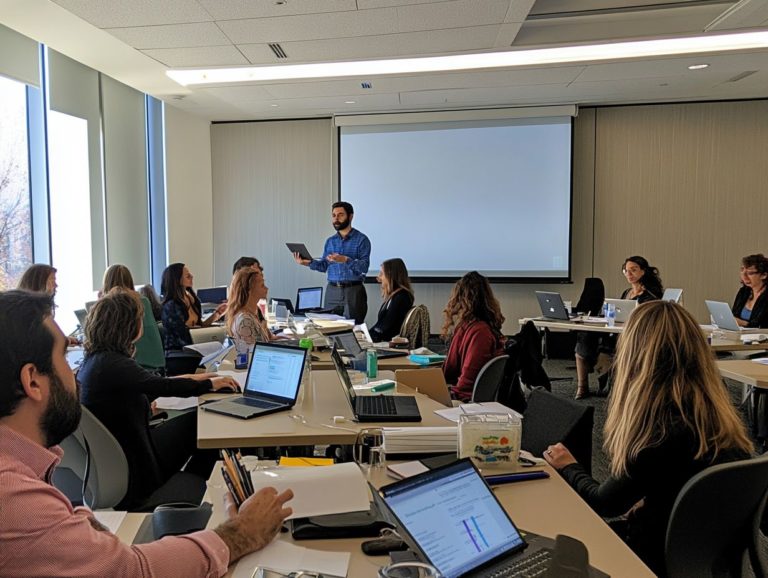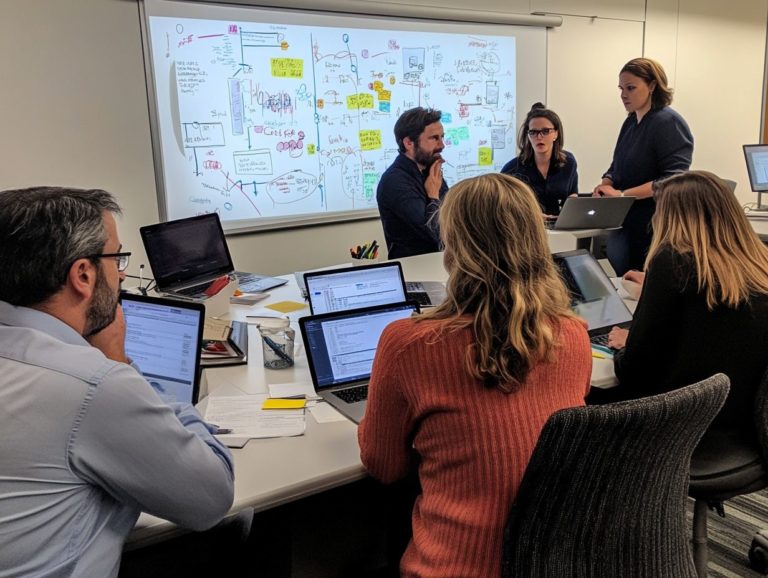Gauging the Impact of Skill Enhancement on Performance
In today s fast-paced world, continuous skill enhancement isn t merely advantageous; it s essential for your success.
Whether you’re aiming to sharpen your technical expertise or cultivate vital soft skills, improving your abilities can significantly elevate your performance.
This article delves into various types of skill enhancement, effective measurement strategies, and the impact honing your skills can have on your career.
We ll also tackle common challenges you might face and offer practical solutions to help you implement successful enhancement strategies.
Join us now to see how investing in your skills can transform your career today!
Contents
- Key Takeaways:
- The Importance of Skill Enhancement
- Types of Skill Enhancement
- Measuring Performance
- Impact of Skill Enhancement on Performance
- Implementing Skill Enhancement Strategies
- Challenges and Solutions
- Frequently Asked Questions
- What is skill enhancement and how does it impact performance?
- How can one gauge the impact of skill enhancement on performance?
- Does skill enhancement always lead to improved performance?
- Can skill enhancement be measured quantitatively?
- Are there any potential drawbacks of skill enhancement on performance?
- How can organizations facilitate skill enhancement for their employees?
Key Takeaways:

- Improving skills is crucial for overall performance.
- Measuring performance through key indicators helps track the impact of skill enhancement.
- Effective implementation can overcome challenges and lead to improved performance.
The Importance of Skill Enhancement
In today s fast-paced business environment, the significance of skill enhancement is paramount. Skills shortages are creating exciting opportunities for learning and growth! You face mounting pressures that demand effective learning strategies focused on employee training and development.
As highlighted by McKinsey & Company, investing in workforce development isn t merely a choice; it s necessary for business. This investment is vital for driving productivity gains and fostering employee engagement, ultimately elevating your organization s overall capability.
Why Improving Skills is Crucial for Performance
Improving your skills is essential for enhancing your performance, as it directly impacts productivity and revenue generation within your organization. For insights on overcoming obstacles, consider exploring understanding the challenges of skill enhancement.
When you prioritize training initiatives, you cultivate a culture of continuous improvement while establishing measurable learning metrics that demonstrate effectiveness. Engaging in skill development not only boosts your own satisfaction but also elevates overall customer experience levels.
Studies from the National Association of Colleges and Employers show that employers increasingly value candidates who exhibit strong critical thinking and problem-solving skills. Platforms like LinkedIn highlight the significance of skill growth, illustrating how these advancements can propel your career forward.
This harmonious relationship between training and real-world application ensures that you and your organization remain competitive and responsive to ever-changing market demands.
Types of Skill Enhancement
Skill enhancement can be divided into two essential categories: technical skills and soft skills. Both are crucial for your overall development and ongoing improvement in the workplace.
Emphasizing these areas will enable you to navigate your career with greater confidence and effectiveness.
Technical Skills
Technical skills encompass the specialized abilities and knowledge you need to execute specific tasks effectively, playing a pivotal role in your skill attainment and overall performance.
These skills are essential across various industries. In healthcare, for example, precision in diagnostics is paramount, while in information technology, your coding expertise can propel software innovation. Consider how advanced metrics like Key Performance Indicators (KPIs) measurable values that demonstrate how effectively a company is achieving key business objectives and Return on Investment (ROI) are often employed to assess the effectiveness of these technical capabilities within organizations.
In today s fast-paced environment, integrating innovative solutions and adapting to emerging technologies is crucial for maintaining a competitive edge. Companies that invest in continuous training and upskilling not only boost employee productivity but also cultivate a culture of agility, which is essential in the ever-evolving marketplace.
Soft Skills

Soft skills are the people skills that enhance employee engagement and elevate customer satisfaction. They are essential in performance management and training programs.
Skills like effective communication, teamwork, and emotional intelligence are crucial in shaping workplace dynamics. They drive organizational success.
When you possess strong communication skills, you can articulate your ideas clearly. This results in fewer misunderstandings and a more productive atmosphere, especially in collaborative projects. Your ability to work well with diverse teams can determine whether a project thrives or falters.
McKinsey & Company shows that including soft skills in training fosters collaboration. Resolving conflicts with diplomacy boosts team cohesion and transforms workplace relationships.
Measuring Performance
Measuring performance is crucial for assessing the effectiveness of training programs. Focus on important metrics to evaluate the return on investment (ROI).
Key Performance Indicators
Important metrics are essential for measuring the ROI of employee training and development. They offer valuable insights into both performance and program satisfaction.
These indicators capture the immediate effects of training and reveal a broader view of long-term benefits. For example, job placement rates indicate how well-trained employees transition into their roles. Meanwhile, employee retention rates showcase the effectiveness of training in nurturing loyalty and job satisfaction.
Utilizing platforms like LinkedIn allows you to access valuable data. You can benchmark these metrics against industry standards, adopting best practices in performance measurement and continuously refining your training strategies for optimal results.
Impact of Skill Enhancement on Performance
The impact of skill enhancement on performance is truly transformative. It directly fuels productivity gains, drives down costs, and boosts revenue generation, while significantly improving employee retention rates, as discussed in the impact of skill enhancement on team dynamics.
Investing in skill development is a game-changer! It not only elevates individual capabilities but also drives the entire organization’s success.
How Improved Skills Affect Performance
Improved skills lead to enhanced employee performance, allowing you to foster innovation and adaptability in an ever-evolving business landscape.
When you prioritize and invest in comprehensive training programs, you often experience a substantial return on investment. Companies like Google and Amazon have established robust training modules that focus on both technical and soft skills, showing a clear link between skill enhancement and overall productivity.
For instance, Google s Project Oxygen revealed that effective management training boosts employee satisfaction and significantly elevates team performance.
Similarly, Amazon s continuous learning approach enables employees to embrace new technologies, strengthening the company’s competitive edge in the market. These case studies illustrate how targeted training can serve as a catalyst for skill development, ultimately benefiting both employees and the organization as a whole.
Implementing Skill Enhancement Strategies

Implementing effective methods to enhance your skills necessitates careful planning. This involves setting clear objectives and identifying cost-effective solutions tailored specifically to your organizational needs.
Effective Methods for Enhancing Skills
Training programs for continuous improvement are crucial for skill development and enhancing organizational capability.
They present a variety of methods tailored to accommodate diverse learning styles and workplace dynamics. For instance, on-the-job training immerses you directly into your tasks, promoting a hands-on approach that facilitates immediate application. In contrast, online courses offer the flexibility to learn at your own pace while providing access to a vast array of resources.
Workshops foster collaborative environments, sparking creativity and problem-solving among peers. Platforms like LinkedIn and tools such as Nestor have transformed the way organizations implement these programs.
Integrating innovative training initiatives can lead to impressive boosts in employee performance and overall productivity.
Challenges and Solutions
Despite the evident advantages, organizations frequently encounter obstacles when measuring the return on investment (ROI) of skill enhancement initiatives. This challenge is often exacerbated by a dependence on subjective metrics and the complexities of economic realities.
Possible Obstacles and How to Overcome Them
Possible obstacles in your journey to skill enhancement may include challenges related to data collection and measurement costs, which can significantly impact the effectiveness of training and skill development.
To navigate these hurdles, consider adopting advanced metrics that offer deeper insights into employee progress and skill acquisition. Companies like Google and IBM have successfully integrated sophisticated analytics to monitor training effectiveness, enabling them to make data-driven decisions that boost learning outcomes.
Enhancing feedback mechanisms can foster a culture of continuous improvement, enabling participants to share their experiences and articulate their needs. Implementing solutions like 360-degree feedback or regular surveys can aid organizations in fine-tuning their training programs, ultimately ensuring that participants receive relevant and impactful development opportunities.
Frequently Asked Questions
What is skill enhancement and how does it impact performance?

Skill enhancement means improving your skills and knowledge. It helps you work more efficiently and produce higher quality results.
How can one gauge the impact of skill enhancement on performance?
You can gauge the impact of skill enhancement on performance using various methods such as performance evaluations, feedback from colleagues and superiors, and tracking key performance indicators like productivity, quality of work, and how to measure skill enhancement effectiveness.
Does skill enhancement always lead to improved performance?
While skill enhancement is generally associated with improved performance, it is not a guarantee. Understanding the impact of skill enhancement on employee engagement reveals that factors such as motivation, work environment, and resources also play a role in determining performance.
Can skill enhancement be measured quantitatively?
Yes, skill enhancement can be measured quantitatively using metrics such as time taken to complete a task, number of errors made, and quantity of work produced. For a deeper understanding, consider exploring key metrics for assessing skill enhancement programs. These metrics can provide tangible evidence of the impact of skill enhancement on performance.
Are there any potential drawbacks of skill enhancement on performance?
One potential drawback of skill enhancement on performance is the time and resources required for training and development. This may temporarily impact productivity, but the long-term benefits of improved skills can outweigh this drawback.
How can organizations facilitate skill enhancement for their employees?
Organizations must actively facilitate skill enhancement through targeted training for their employees by providing training and development opportunities, setting aside dedicated time and resources for learning and growth, and recognizing and rewarding employees who invest in their own skill enhancement.






